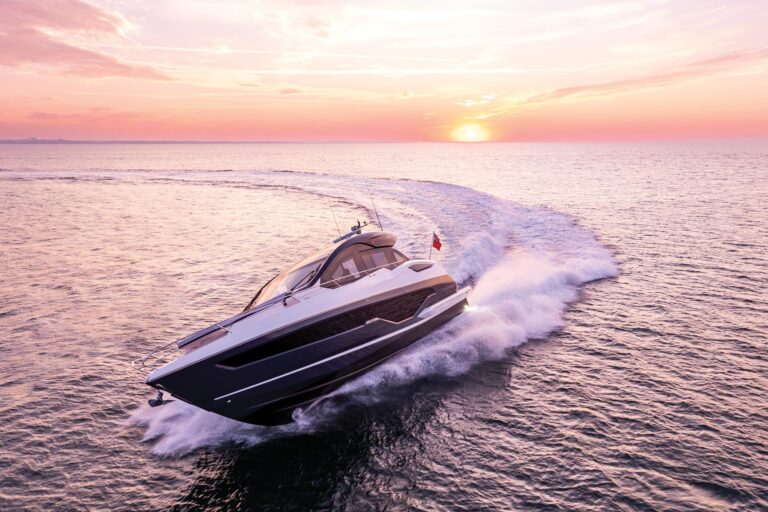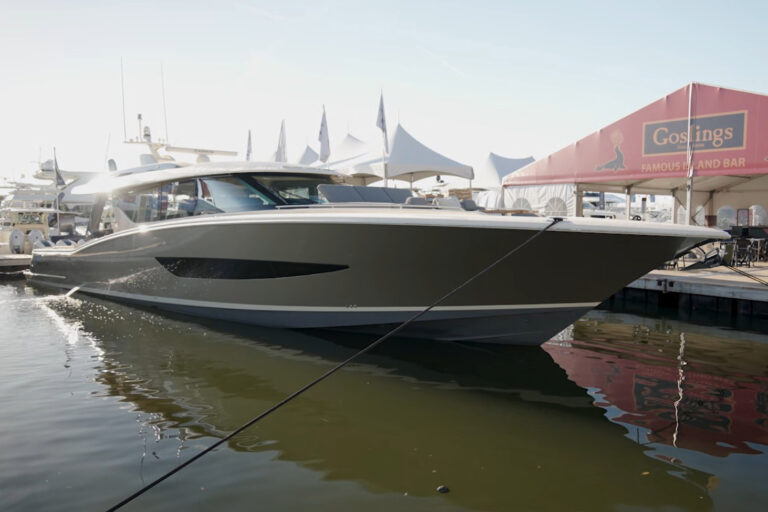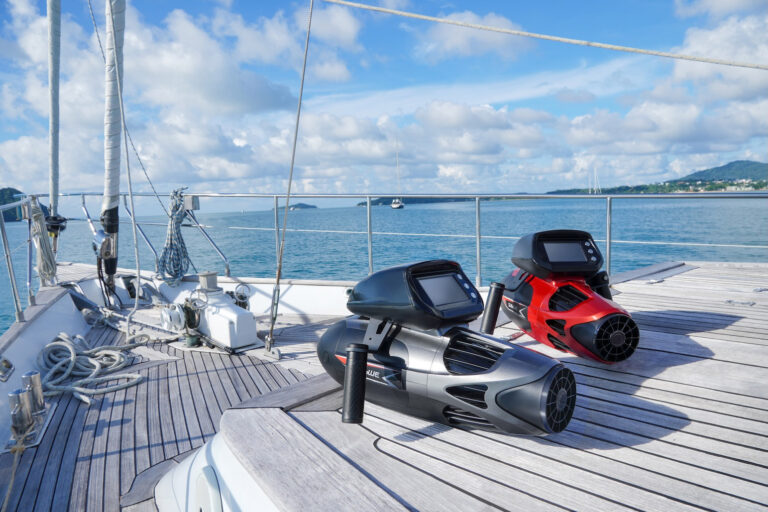Maptech, a company best known for its wide range of marine chart and related cartographic products, has entered the well-populated electronic chart plotter market with an innovative, integrated navigation and optional communication, system-the i3. In addition to functioning as a WAAS GPS chart plotter with depth-sounder input, it can also display radar data as a stand-alone image or overlaid on an electronic chart. Optional satellite communication modules provide a communication interface for E-mail, weather information and graphics. Additional internal resources include the USCG Coast Pilot and a comprehensive Help menu.
With the exception of the +, – and Power keys, all of the system commands are entered by touching the appropriate point on the screen. For those times when the boat and the user are being tossed about in a seaway, Maptech includes a form of infrared computer mouse that has two keys plus either a joystick or pressure-sensitive button. Mounted in a position where the user’s hand can remain fixed in place, finger movement provides accurate input commands for the on-screen cursor even in very rough conditions.
As with all chart plotters the overall usability of the i3 is determined by the quality of the display screen. The specified screen brightness of 1500 NIT, SVGA (800 x 600 pixel) resolution, 24-bit color and high contrast produce an excellent, easy to see image that is viewable over a wide horizontal angle. Once installed in an instrument panel the unit is completely splashproof.
The Maptech i3 differs from most chart plotters in its use of raster-scanned NOAA nautical and topographic charts, including: Maptech’s BSB format nautical charts (official NOAA nautical charts), Coastal Topographic Maps, Contour Series (3D bathymetric) charts and Coastal Navigation Photos. Each of these chart types can be shown as full-screen or split-screen images. The system’s smart depth transducer provides data for both conventional depth display information and the contour chart image.
Some of the flexibility of vector charts is necessarily lacking, including the ability to automatically rotate legends to keep them easily readable when the chart image is displayed in a Course Up or Heading Up mode. The chart cannot be de-cluttered by deleting layered data groups. However, I found that the relatively large size of the i3’s display screen and the system’s very rapid response to scroll and zoom commands eliminated the need to de-clutter the chart image. In my opinion rotated chart legends pose no problems.
The i3 provides all of the chart plotter capabilities expected in today’s high-end systems, including point and shoot placement and easy relocation of waypoints, route construction and easy modification, measurement of range and bearing and preset depth alarm with chart-based look-ahead. Waypoint enumeration is aided by the use of a virtual QWERTY keyboard image that appears on the screen when the Tools button is selected. Chart scale can be altered using the + and – controls or by direct selection of the desired scale from a menu. Charts can be displayed in any of three orientations, Chart Up, North Up or Course Up.
One of the i3’s features is the ability to overlay a chart image with range rings similar to those available on radar displays. However, in addition to the usual defined distance intervals, the rings can be set to show the distance that the vessel will travel in a preset time. In this mode the ring spacing will change in concert with changes in the boat’s speed over the ground. Combined with the charted depth look-ahead window, this feature should help prevent unintended and possibly costly contact with immovable objects.
Two optional external modules can be connected to the i3: a SkyMate VHF module for E-mail communication via the ORBCOMM satellite system, and a Weather Channel Marine module for access to live WSI NOWrad weather radar images and a wide range of related weather products. The SkyMate option can be expanded to include remote monitoring of onboard conditions including status of shore power, bilge water level and battery voltage, and can also be configured to automatically transmit vessel position reports. Both of the communication modules require a service contract.
The advertised price of the basic system is $12,500. Fully expanded with a 4 kW open array radar, SkyMate and WSI NOWrad modules will run approximately $20,000 to $25,000, professionally installed. Cost of a chart package is approximately $500 per region, including all types of charts/photos.
Contact: Maptech, (888) 839-5551; www.maptech.com.
Garmin’s new network-capable GPSMAP 3010C chart plotter, when connected to the optional GDL 30 (or the GDL 30A, which includes an audio channel interface) marine weather satellite receiver, can display fully integrated, up-to-the-minute weather information downloaded from the XM satellite system. In addition to chart and weather data, the system will display sonar data from the optional GSD 20 sounder module. The addition of a new radar sensor early in 2005 will make the 3010C a multifunctional navigation center.
The design of the WAAS-enabled GPSMAP 3010C plotter’s control logic and operating system makes them easy to learn and easy to use. Anyone familiar with Garmin’s previous chart plotter products will enjoy a short and efficient learning process. The plotter can be either panel or bracket mounted and is waterproof. This system’s ability to access and integrate a mass of real-time to almost-real-time weather information with the on-screen chart image is impressive. The Hide Weather/Show Weather soft key instantly displays or removes selected weather data from the screen.
It is important to recognize that the displayed weather radar data has been digitally processed and therefore will not necessarily resemble what you see on your boat’s normal radar. The intensity of the radar signal returned from precipitation is digitized and converted into a color spectrum, usually with bright red or magenta indicating the most intense rainfall. However, the need to limit the size of the data package being transmitted results in an image lacking in fine detail, so the picture resembles a TV broadcast weather radar image. Interpreting radar data presented in this form is simple-stay away from the red and magenta areas.
Using the “Animate” feature in the adjustment menu for the Map function presents a series of six successive frames of NEXRAD data, each approximately five minutes apart. Using this mode simplifies analysis of changes in the shape, size and movement of the weather radar image. Use your vessel’s radar to provide the instantaneous, close-in weather information and the NEXRAD images to show you what lurks beyond the boat’s radar horizon.
WxWorx, a weather data processing service, produces the various XM weather data, including some particularly interesting and useful displays for mariners such as storm-cell depiction. This mode shows the latest position of a radar-detected storm cell, its relative size and its projected path at 15-minute intervals. This picture, combined with ground-lightning-strike data, can be really useful when “getting out of Dodge” is the prudent thing to do. Sea-surface wind speed and direction information is depicted in the same format used on pilot charts. Atmospheric pressure is depicted as isobars with a similar format used to show surface visibility. Of primary use for long-range planning, and to better understand what will happen in the cruising days just ahead, the “Fronts” option includes the position and nature of highs, lows and all fronts regionally or for the entire continent. Sea-surface data obtained from satellite, buoy and ship reports, combined with computer models of the ocean, yield surface temperature of the water, wave height, wave period and wave direction information.
Suggested retail for the GPSMAP 3010C is $2,857. Three monthly weather service subscription choices are offered: Fisherman, a 12-item menu of weather data for $30; Sailor, with an 11-item menu for $30; or Master Mariner with a 19-item menu at $50. The one-time activation fee is $50. An entertainment radio subscription (must have GDL 30A) runs $7 per month plus an activation fee of $15. The XM subscriptions run month to month, therefore the owner of a boat that will be out of service for more than two months will be ahead of the game by terminating the subscription and paying a new activation fee when the boat goes back in service. n
Contact: Garmin, (888) 442-7646; www.garmin.com.









